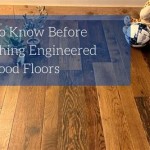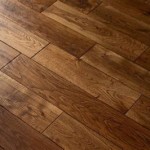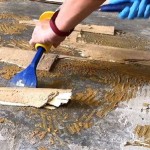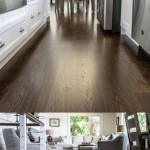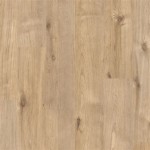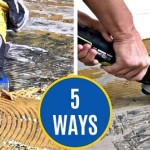How To Fix Termite Damaged Wood Floors
Termite damage to wood floors can be a significant problem for homeowners. Left untreated, these infestations can compromise the structural integrity of the flooring and, potentially, the entire building. Addressing termite damage requires a systematic approach involving identification, assessment, treatment, and repair. This article outlines the steps involved in fixing termite-damaged wood floors, providing a comprehensive guide for homeowners and professionals alike.
Identifying Termite Damage
The first, and arguably most critical, step in fixing termite-damaged wood floors is accurate identification. Termite infestations are often subtle in their early stages, making detection challenging. Understanding the signs of termite activity is essential for prompt intervention.
One common sign is the presence of mud tubes. Termites, particularly subterranean termites, construct these tubes to travel between their colony and the wood source they are feeding on. These tubes are typically found along foundation walls, in crawl spaces, or even on the surface of the wood floor itself. They provide a protected pathway for the termites, shielding them from predators and desiccation.
Another indicator is blistered or hollow-sounding wood. Termites consume the interior of the wood, leaving the outer layer intact. When tapped, this wood may sound hollow or feel weak. A visual inspection may reveal surface blisters or cracks, indicating underlying damage.
Frass, or termite droppings, is another telltale sign. Termites excrete frass as they tunnel through the wood. Depending on the species, frass can appear as small, granular pellets or a powdery substance. It is often found near termite entry points or along the edges of infested wood.
Finally, swarming termites are a clear indication of a nearby infestation. Swarming termites are reproductive members of the colony that fly off to establish new colonies. These swarmers are often attracted to light and may be seen near windows or doors.
Distinguishing between termite damage and other types of wood damage, such as dry rot or water damage, is also important. Dry rot is caused by fungi and typically results in a soft, spongy texture in the wood. On the other hand, water damage can cause warping, staining, and decay. A thorough inspection can help determine the cause of the damage and the appropriate course of action.
Assessing the Extent of the Damage
Once termite damage has been identified, it is crucial to assess the extent of the problem. This assessment will determine the scope of the repair work required and the necessary treatment options.
A visual inspection is the first step in assessing the damage. Carefully examine the affected area, looking for signs of termite activity, such as mud tubes, frass, and damaged wood. Pay particular attention to areas where the floor comes into contact with walls or other structures, as these are common entry points for termites.
Probing the wood with a screwdriver or awl can help determine the extent of internal damage. If the wood is soft or easily penetrated, it indicates significant termite activity. Probe in multiple locations to get a comprehensive understanding of the affected area.
Removing sections of the flooring may be necessary to fully assess the damage. This will allow for a closer inspection of the subfloor and framing. Be prepared to replace any flooring that is removed during this process.
Consider consulting with a qualified pest control professional. They can conduct a thorough inspection and provide a detailed report on the extent of the termite infestation and the recommended treatment options. They may also use specialized equipment, such as moisture meters and thermal imaging cameras, to detect hidden termite activity.
Documenting the damage with photographs is essential for insurance purposes and for tracking the progress of the repair work. Take clear, well-lit photos of the affected areas before, during, and after treatment and repair.
Treating the Termite Infestation
Treating the termite infestation is a critical step in preventing further damage to the wood floors. Several treatment options are available, each with its own advantages and disadvantages. The best approach will depend on the type of termite, the extent of the infestation, and the specific characteristics of the building.
Soil treatment involves applying a liquid termiticide to the soil around the foundation of the building. This creates a treated zone that prevents termites from entering the structure. This method is effective for controlling subterranean termites, which are the most common type of termite.
Baiting systems involve placing termite baits in the ground around the building. These baits contain a slow-acting insecticide that termites consume and carry back to the colony. This can effectively eliminate the entire colony over time. Baiting systems are a less invasive option than soil treatment, but they may take longer to achieve results.
Direct wood treatment involves applying a termiticide directly to the infested wood. This can be done by spraying, brushing, or injecting the termiticide into the wood. Direct wood treatment is effective for controlling localized infestations and preventing further damage.
Fumigation is a more extensive treatment option that involves sealing the building and releasing a fumigant gas to kill the termites. This method is effective for treating severe infestations that are difficult to reach with other methods. However, fumigation requires extensive preparation and can be disruptive to the building occupants.
Consider using borate-based wood preservatives. Borates are a natural mineral that is toxic to termites and other wood-boring insects. They can be applied to the wood as a preventative measure or as a treatment for existing infestations. Borates are relatively non-toxic to humans and pets, making them a safe and effective option.
It is highly recommended to hire a licensed pest control professional to perform the termite treatment. They have the expertise and equipment necessary to effectively eliminate the infestation and prevent future problems. They can also provide a warranty for their work, giving you peace of mind.
Repairing the Damaged Wood Floors
After the termite infestation has been treated, the next step is to repair the damaged wood floors. The extent of the repair work will depend on the severity of the damage. In some cases, only minor repairs may be necessary. In other cases, extensive replacement of the flooring may be required.
For minor damage, such as small holes or cracks, wood filler can be used to repair the affected areas. Clean the damaged area thoroughly and apply the wood filler according to the manufacturer's instructions. Once the filler has dried, sand it smooth and finish it to match the surrounding flooring.
For more extensive damage, such as rotted or weakened boards, it may be necessary to replace the affected sections of the flooring. Carefully remove the damaged boards, taking care not to damage the surrounding flooring. Cut new boards to the correct size and shape and install them using nails, screws, or adhesive. Be sure to match the wood species and grain pattern of the existing flooring.
If the damage is widespread, it may be necessary to replace the entire floor. This is a more involved process, but it may be the only option if the damage is too extensive to repair. Remove the old flooring and inspect the subfloor for any damage. Repair or replace the subfloor as needed before installing the new flooring.
When replacing flooring, consider using termite-resistant materials. Treated lumber, composite wood, and certain types of hardwoods are naturally resistant to termites. Using these materials can help prevent future infestations.
For structural repairs, consult with a qualified contractor. Termite damage can compromise the integrity of the floor joists and other structural components. A contractor can assess the damage and make the necessary repairs to ensure the safety and stability of the building.
After the repairs have been completed, it is important to properly finish the flooring. This will protect the wood from moisture and other damage and enhance its appearance. Apply a sealant or stain to the repaired areas to match the existing flooring. Then, apply a coat of polyurethane or other protective finish to the entire floor.
Preventing Future Termite Infestations
Preventing future termite infestations is essential for protecting your wood floors and your home. Several steps can be taken to reduce the risk of termite activity.
Eliminate moisture sources. Termites are attracted to moisture, so it is important to eliminate any sources of standing water around the foundation of the building. Repair any leaky pipes or faucets and ensure that the gutters and downspouts are functioning properly.
Remove wood debris. Termites feed on wood, so it is important to remove any wood debris from around the foundation of the building. This includes firewood, mulch, and tree stumps.
Maintain a clear space between the soil and the wood. Termites often enter buildings through the soil, so it is important to maintain a clear space between the soil and the wood. Remove any vegetation or debris that is in contact with the foundation.
Regularly inspect the wood floors for signs of termite activity. As described earlier, look for mud tubes, frass, and damaged wood. If you suspect a termite infestation, contact a qualified pest control professional for an inspection and treatment.
Consider using termite-resistant construction materials. When building or remodeling, use treated lumber, composite wood, or other materials that are naturally resistant to termites.
Apply a preventative termiticide treatment. A pest control professional can apply a termiticide to the soil around the foundation of the building to create a treated zone that prevents termites from entering. This treatment should be reapplied periodically to maintain its effectiveness.
By taking these preventative measures, homeowners can significantly reduce the risk of termite infestations and protect their wood floors from damage.

How To Fix A Termite Damaged Hardwood Floor Root Simple

Termite Damage On Hardwood Floor Quickly Repaired

Repair Termite Hole In Hardwood Floor Hometalk

The Types Of Termites That Can Damage Your Hardwood Floors And How To Fix Them

Termite Damaged Boards Fullerton 1 22 2024 Refinishwoodfloors Woodfloors

Assessing Termite Damage In Timber Floors

How Do You Repair Termite Damage El Gato Painting

How To Fix A Termite Damaged Hardwood Floor Root Simple

A Little Hardwood Floor Repair The Space Between

Repair Hole In Damaged Hardwood Floor Slaughterbeck Floors Inc
See Also
